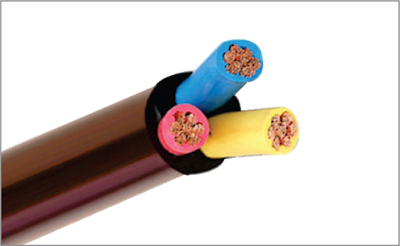The accompanying study was preformed to straightforwardly compare
11mm square with 11mm round encapsulation of 4mm Cable. Different things were
examined, including: Manufacturability, Flexibility, Dynamic Friction, Crush
Strength, weight, Cross-Sectional Twisting and Deployment/Retrieval. Round cable
outperforms square cable in flexibility, crush strength and weight. There are
additionally issues with twisting and
manufacturing of the square encapsulate
down the hub of the wire amid sending and recovery. All these factors increase the possibility of harm and wear in
operation.
The study demonstrates that square encapsulated cable will have a general higher expense of
possession than round encapsulated cables.
Manufacturability
Expelling plastic encapsulating material over a center of other
material (Steel, Copper, etc) is a developed procedure that has dominated cable
manufacturing since the 1960's.
Although generally round in cross-area, wire can be made in
square, hexagonal, smoothed rectangular or different cross-segments for
particular applications, for example, house wiring.
Because of the rigidity and natural arc of the 4mm wire keeping it concentric
will be more troublesome for the cable producer. This focuses to the need to
utilization of higher end manufacturing facilities that have the capacity to
deliver a consistent product. This might deliver a higher quality, at the same
time, will probably expand cost, lead-time, and limit manufacturing at low
expenses centers.
Weight
All things
being equal material and wire, the 11mm square encapsulated cable weights ~11%
more than an 11mm round encapsulated cable. This is because of the way that
there is more material in a square than a round profile.
Flexibility
A Round
cable is more adaptable than the square cable. A round cross-area has
the same imperviousness to twisting regardless of which direction it is moved
in. Square, then again, has differing imperviousness to twisting because of the
thicker areas. Results of simulation show round cable is 34-40% more adaptable
than square.
Crush
Strength
Crush
strength simulations performed utilizing simulation can be utilized as a marker
to the execution under a given circumstance. At the point when crushing strengths
were connected to an area of cable signs demonstrate that both Round and square
cross-segments apply about the same power straightforwardly to the encapsulated
wire. This simulation assumes that the wire is concentric in the encapsulation.
Simulations on a cross-segment of the real Square cable show powers are higher
face of the wire. It has been watched that, practically speaking, it is hard to
keep the wire concentric with the square cross-area encapsulation.
Cross-Sectional
twisting
There is a
propensity of the square cross-segment encapsulated cable to twist along the
pivot of the wire when conveyed and recovered. This will increment both the
volume required on the reel and in addition the frictional powers connected to
the cable amid sending and recovery. Round cross-area cable, regardless of the
fact that it turns along the hub won't increase volume on the reel or
frictional strengths.
Dynamic
Friction
Friction is
an element of weight, surfaces in contact (harshness), and speed of recovery.
Every function has a bearing on the strengths should have been connected to the
cable while being sent and recovered. On the off chance that a cable weights
progressively and has rougher surface more powers will be connected. Square
cable has more weight and a rougher surface line (twisting down the pivot) so
it will decrease the operational life of the square cable over the round.
With more friction
comes more wear, it would be normal that this will decrease the operational
existence of the square cable over the round cable.
Deployment/Retrieval
At the point
when conveyed from the production line both round and square encapsulated cable
lay perfectly onto the reel. After deployment and recovery the cable can be a twisted
disorder on the reel. Twisting forces on the square cable will reduce the
adaptability (reasonability) of the cable and additionally improve the range needs
on the reel for the cable. Reels should be sufficiently huge to compensate for
the additional region it will take up when recovered.
Round cable, despite the fact that it can in any
case be hard to manage won't be affected by twisted and frictional powers to
the degree the square cable.

No comments:
Post a Comment